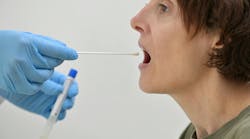A new study from The University of Manchester has revealed that the incidence of dermatitis has increased 4.5 times in healthcare workers following increased hand hygiene as a drive to reduce infections such as MRSA and C. Difficile has kicked in. The paper, “'The impact of national level interventions to improve hygiene on the incidence of irritant contact dermatitis in healthcare workers: changes in incidence from 1996-2012 and interrupted times series analysis,” was recently published in the British Journal of Dermatology.
Researchers from the University's Institute of Population Health studied reports voluntarily submitted by dermatologists to a national database which is run by the University (THOR), between 1996 and 2012. Sixty percent of eligible UK dermatologists used this database, which is designed to report skin problems caused or aggravated by work. They found that out of 7,138 cases of irritant contact dermatitis reported, 1,796 were in healthcare workers. When the numbers were broken down by year, health workers were 4.5 times more likely to suffer from irritant contact dermatitis in 2012 as in 1996. In two control groups, cases declined or did not change.
Dr Jill Stocks, who led the research, says, “Campaigns to reduce these infections have been very successful and many lives have been saved. However, we need to do all we can to prevent skin irritation among these frontline workers.”
The implications of increasing levels of irritant dermatitis are potentially counterproductive to the aims of infection-reducing campaigns. Other studies have identified that infections can remain present for longer on damaged and broken skin and having irritated skin can put people off washing their hands.
Dr Stocks says, “Obviously we don't want people to stop washing their hands, so more needs to be done to procure less irritating products and to implement practices to prevent and treat irritant contact dermatitis.”
Read the study abstract at the British Journal of Dermatology





